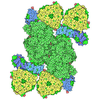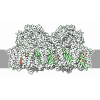[English] 日本語
 Yorodumi
Yorodumi- PDB-6wj6: Cryo-EM structure of apo-Photosystem II from Synechocystis sp. PC... -
+ Open data
Open data
- Basic information
Basic information
| Entry | Database: PDB / ID: 6wj6 | |||||||||
|---|---|---|---|---|---|---|---|---|---|---|
| Title | Cryo-EM structure of apo-Photosystem II from Synechocystis sp. PCC 6803 | |||||||||
 Components Components |
| |||||||||
 Keywords Keywords | PHOTOSYNTHESIS / Photosystem / oxidoreductase / water-splitting / photoactivation | |||||||||
| Function / homology |  Function and homology information Function and homology informationplasma membrane-derived thylakoid photosystem II / oxygen evolving activity / photosystem II reaction center / photosystem II / oxidoreductase activity, acting on diphenols and related substances as donors, oxygen as acceptor / photosynthetic electron transport chain / photosystem II / response to herbicide / chlorophyll binding / plasma membrane-derived thylakoid membrane ...plasma membrane-derived thylakoid photosystem II / oxygen evolving activity / photosystem II reaction center / photosystem II / oxidoreductase activity, acting on diphenols and related substances as donors, oxygen as acceptor / photosynthetic electron transport chain / photosystem II / response to herbicide / chlorophyll binding / plasma membrane-derived thylakoid membrane / photosynthetic electron transport in photosystem II / phosphate ion binding / photosynthesis, light reaction / : / photosynthesis / electron transfer activity / protein stabilization / iron ion binding / heme binding / metal ion binding / identical protein binding Similarity search - Function | |||||||||
| Biological species |  | |||||||||
| Method | ELECTRON MICROSCOPY / single particle reconstruction / cryo EM / Resolution: 2.58 Å | |||||||||
 Authors Authors | Gisriel, C.J. | |||||||||
| Funding support |  United States, 1items United States, 1items
| |||||||||
 Citation Citation |  Journal: Joule / Year: 2020 Journal: Joule / Year: 2020Title: Cryo-EM Structure of Monomeric Photosystem II from Synechocystis sp. PCC 6803 Lacking the Water-Oxidation Complex Authors: Gisriel, C.J. / Zhou, K. / Huang, H. / Debus, R.J. / Xiong, Y. / Brudvig, G.W. | |||||||||
| History |
|
- Structure visualization
Structure visualization
| Movie |
 Movie viewer Movie viewer |
|---|---|
| Structure viewer | Molecule:  Molmil Molmil Jmol/JSmol Jmol/JSmol |
- Downloads & links
Downloads & links
- Download
Download
| PDBx/mmCIF format |  6wj6.cif.gz 6wj6.cif.gz | 448.1 KB | Display |  PDBx/mmCIF format PDBx/mmCIF format |
|---|---|---|---|---|
| PDB format |  pdb6wj6.ent.gz pdb6wj6.ent.gz | 367.8 KB | Display |  PDB format PDB format |
| PDBx/mmJSON format |  6wj6.json.gz 6wj6.json.gz | Tree view |  PDBx/mmJSON format PDBx/mmJSON format | |
| Others |  Other downloads Other downloads |
-Validation report
| Summary document |  6wj6_validation.pdf.gz 6wj6_validation.pdf.gz | 3.6 MB | Display |  wwPDB validaton report wwPDB validaton report |
|---|---|---|---|---|
| Full document |  6wj6_full_validation.pdf.gz 6wj6_full_validation.pdf.gz | 3.8 MB | Display | |
| Data in XML |  6wj6_validation.xml.gz 6wj6_validation.xml.gz | 110 KB | Display | |
| Data in CIF |  6wj6_validation.cif.gz 6wj6_validation.cif.gz | 141.1 KB | Display | |
| Arichive directory |  https://data.pdbj.org/pub/pdb/validation_reports/wj/6wj6 https://data.pdbj.org/pub/pdb/validation_reports/wj/6wj6 ftp://data.pdbj.org/pub/pdb/validation_reports/wj/6wj6 ftp://data.pdbj.org/pub/pdb/validation_reports/wj/6wj6 | HTTPS FTP |
-Related structure data
| Related structure data |  21690MC M: map data used to model this data C: citing same article ( |
|---|---|
| Similar structure data |
- Links
Links
- Assembly
Assembly
| Deposited unit | 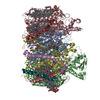
|
|---|---|
| 1 |
|
- Components
Components
-Photosystem II ... , 11 types, 11 molecules ABCDHIKLMTX
| #1: Protein | Mass: 39744.117 Da / Num. of mol.: 1 / Source method: isolated from a natural source Source: (natural)  Strain: PCC 6803 / Kazusa / References: UniProt: P16033, photosystem II |
|---|---|
| #2: Protein | Mass: 55954.355 Da / Num. of mol.: 1 / Source method: isolated from a natural source Source: (natural)  Strain: PCC 6803 / Kazusa / References: UniProt: P05429 |
| #3: Protein | Mass: 50330.695 Da / Num. of mol.: 1 / Source method: isolated from a natural source Source: (natural)  Strain: PCC 6803 / Kazusa / References: UniProt: P09193 |
| #4: Protein | Mass: 39519.238 Da / Num. of mol.: 1 / Source method: isolated from a natural source Source: (natural)  Strain: PCC 6803 / Kazusa / References: UniProt: P09192, photosystem II |
| #7: Protein | Mass: 7120.404 Da / Num. of mol.: 1 / Source method: isolated from a natural source Source: (natural)  Strain: PCC 6803 / Kazusa / References: UniProt: P14835 |
| #8: Protein/peptide | Mass: 4310.109 Da / Num. of mol.: 1 / Source method: isolated from a natural source Source: (natural)  Strain: PCC 6803 / Kazusa / References: UniProt: Q54697 |
| #9: Protein/peptide | Mass: 5114.127 Da / Num. of mol.: 1 / Source method: isolated from a natural source Source: (natural)  Strain: PCC 6803 / Kazusa / References: UniProt: P15819 |
| #10: Protein/peptide | Mass: 4476.145 Da / Num. of mol.: 1 / Source method: isolated from a natural source Source: (natural)  Strain: PCC 6803 / Kazusa / References: UniProt: Q55354 |
| #11: Protein/peptide | Mass: 3882.630 Da / Num. of mol.: 1 / Source method: isolated from a natural source Source: (natural)  Strain: PCC 6803 / Kazusa / References: UniProt: P72701 |
| #12: Protein/peptide | Mass: 3543.308 Da / Num. of mol.: 1 / Source method: isolated from a natural source Source: (natural)  Strain: PCC 6803 / Kazusa / References: UniProt: P74787 |
| #13: Protein/peptide | Mass: 4189.036 Da / Num. of mol.: 1 / Source method: isolated from a natural source Source: (natural)  Strain: PCC 6803 / Kazusa / References: UniProt: P72575 |
-Cytochrome b559 subunit ... , 2 types, 2 molecules EF
| #5: Protein | Mass: 9454.577 Da / Num. of mol.: 1 / Source method: isolated from a natural source Source: (natural)  Strain: PCC 6803 / Kazusa / References: UniProt: P09190 |
|---|---|
| #6: Protein/peptide | Mass: 4935.784 Da / Num. of mol.: 1 / Source method: isolated from a natural source Source: (natural)  Strain: PCC 6803 / Kazusa / References: UniProt: P09191 |
-Sugars , 2 types, 4 molecules 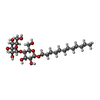
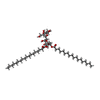

| #21: Sugar | | #22: Sugar | |
|---|
-Non-polymers , 13 types, 267 molecules 
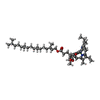

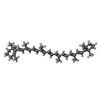
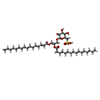
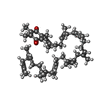
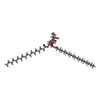

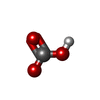
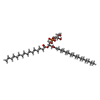

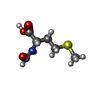













| #14: Chemical | ChemComp-FE2 / | ||||||||||||||||||||||
|---|---|---|---|---|---|---|---|---|---|---|---|---|---|---|---|---|---|---|---|---|---|---|---|
| #15: Chemical | ChemComp-CLA / #16: Chemical | #17: Chemical | ChemComp-BCR / #18: Chemical | ChemComp-SQD / #19: Chemical | #20: Chemical | #23: Chemical | ChemComp-CL / | #24: Chemical | ChemComp-BCT / | #25: Chemical | ChemComp-LHG / #26: Chemical | ChemComp-HEM / | #27: Chemical | #28: Water | ChemComp-HOH / | |
-Details
| Has ligand of interest | Y |
|---|
-Experimental details
-Experiment
| Experiment | Method: ELECTRON MICROSCOPY |
|---|---|
| EM experiment | Aggregation state: PARTICLE / 3D reconstruction method: single particle reconstruction |
- Sample preparation
Sample preparation
| Component | Name: apo-Photosystem II / Type: COMPLEX / Entity ID: #1-#13 / Source: NATURAL |
|---|---|
| Molecular weight | Value: 0.267067 MDa / Experimental value: NO |
| Source (natural) | Organism:  Strain: PCC 6803 / Kazusa |
| Buffer solution | pH: 7 Details: 10 mM HEPES pH 7.0 100 mM NaCl 0.03% beta-dodecylmaltoside |
| Specimen | Conc.: 0.025 mg/ml / Embedding applied: NO / Shadowing applied: NO / Staining applied: NO / Vitrification applied: YES / Details: Monodisperse single particles |
| Specimen support | Grid material: COPPER / Grid mesh size: 300 divisions/in. / Grid type: C-flat-2/1 |
| Vitrification | Instrument: FEI VITROBOT MARK IV / Cryogen name: ETHANE / Humidity: 100 % / Chamber temperature: 298 K |
- Electron microscopy imaging
Electron microscopy imaging
| Experimental equipment |  Model: Titan Krios / Image courtesy: FEI Company |
|---|---|
| Microscopy | Model: FEI TITAN KRIOS |
| Electron gun | Electron source:  FIELD EMISSION GUN / Accelerating voltage: 300 kV / Illumination mode: FLOOD BEAM FIELD EMISSION GUN / Accelerating voltage: 300 kV / Illumination mode: FLOOD BEAM |
| Electron lens | Mode: BRIGHT FIELD |
| Image recording | Electron dose: 48.07 e/Å2 / Film or detector model: GATAN K2 SUMMIT (4k x 4k) |
- Processing
Processing
| EM software | Name: RELION / Version: 3.1 / Category: 3D reconstruction |
|---|---|
| CTF correction | Type: NONE |
| Symmetry | Point symmetry: C1 (asymmetric) |
| 3D reconstruction | Resolution: 2.58 Å / Resolution method: FSC 0.143 CUT-OFF / Num. of particles: 212640 / Symmetry type: POINT |
 Movie
Movie Controller
Controller



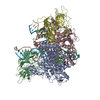



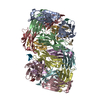
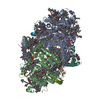
 PDBj
PDBj